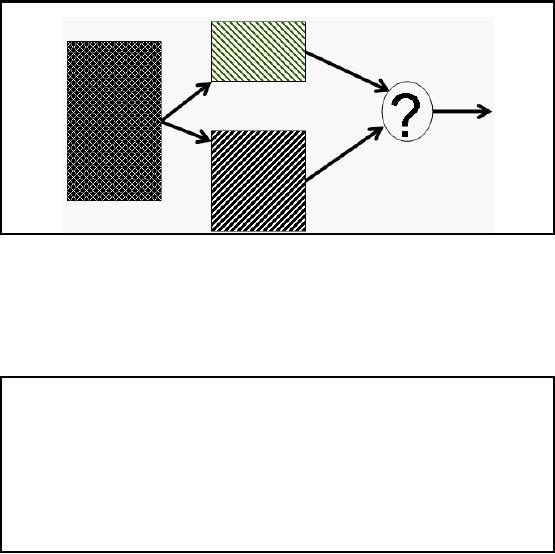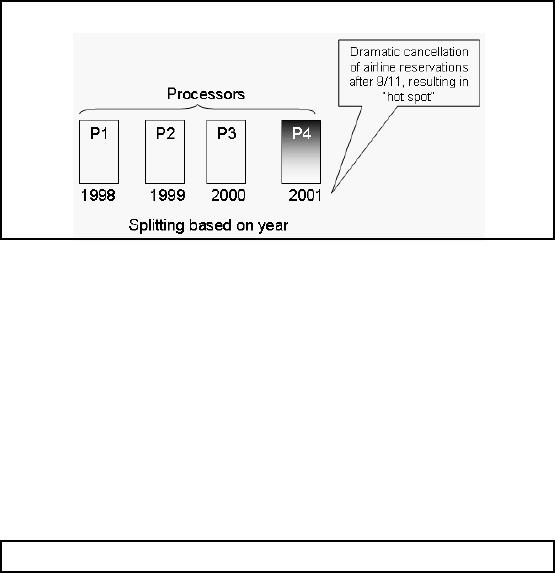 |

Lecture
Handout
Data
Warehousing
Lecture
No. 09
Issues of
De-Normalization
�
Storage
�
Performance
�
Maintenance
�
Ease-of-use
The effects of
denormalization on database performance are
unpredictable: as many
applications/users
can be affected negatively by denormalization when
some applications are
optimized. If a
decision is made to denormalize,
make sure that the
logical model has been
fully
normalized to
3NF. Also document the pure
logical model and keep your
documentation of the
physical model
current as well. Consider the following
list of effects of denormalization before
you decide to
undertake design
changes.
The trade-offs
of denormalization are as follows:
�
Storage
�
Performance
�
Ease-of-use
�
Maintenance
Each of
these tradeoffs must be considered when
deploying denormalization into a
physical
design.
Typically, architects are
pretty good at assessing performance and
storage implications of
a denormalization
decision. Factors that are
notoriously under estimated are the
maintenance
implications and
the impact on usability/flexibility
for the physical data
model.
Storage
Issues: Pre-joining
�
Assume
1:2 record count ratio
between claim master and detail
for health-care
application.
�
Assume 10
million members (20 million
records in claim
detail).
�
Assume 10
byte member_ID.
�
Assume 40
byte header for master
and 60 byte header for
detail tables.
By understanding
the characteristics of the
data, the storage
requirements can actually be
quantified
before pre -joining. We need to
know the size of the
data from the master
table that
53

will be
replicated for pre -joining
into the detail table as
well as the number of detail records
(on
average) in the
header that will be
denormalized as a result of pre
-joining.
In this
example, it is assumed that
that each master table
record has two detail record
entries
associated
with it (on average). Note that
this ratio will vary
depending on the nature of
each
industry
and business within an industry.
The health-care industry would be
much closer to a 1:2
ratio, depending
on if the data is biased
towards individual or organizational
claims. A 1:3 ratio
could be
reasonable for a video rental
store, but a grocery store with
tens of thousands of
items,
the ratio
would typically be on the plus
side of 1:30 detail records
for each master table
entry. It is
important to
know the characteristics in
your specific environment to
properly and correctly
calculate
the storage requirements of
the pre -joining
technique.
Storage
Issues: Pre-joining
With
normalization:
Total
space used = 10 x 40 + 20 x 60 = 1.6
GB
After
denormalization:
Total
space used = (60 + 40
10) x 20 = 1.8 GB
Net result is
12.5% additional space required in raw
data table size for
the database.
The
12.5% investment in additional storage
for pre -joining will dramatically
increase
performance for
queries which would otherwise
need to join the very large
header and detail
tables.
Performance
Issues: Pre-joining
Consider the
query "How many members were
paid claims during last
year?"
With
normalization:
Simply count
the number of records in the
master table.
After
denormalization:
The
member_ID would be repeated,
hence need a count distinct.
This will cause
sorting
on a larger
table and degraded
performance.
How
the corresponding query will perform
with normalization and after
denormalization? This a
good question,
with a surprising answer. Observe that
with normalization there are unique
values
in the
master table, and the
number of records in the
master table is the required
answer. To get
this
answer, there is probably no need to
touch that table, as the
said information can be
picked
from
the meta-data corresponding to that
table. However, it is a different
situ tion after pre -
a
joining
has been performed. Now
there are multiple i.e.
repeating member_IDs in the joined
table. Thus
accessing the meta-data is
not going to help. The
only viable option is to
perform a
count distinct,
easier said than done.
The reason be ing this
will require a sort operation,
and then
dropping
the repeating value. For
large tables, it is going to kill
the performance of the
system.
Performance
Issues: Pre-joining
54

Depending on the
query, the performance
actually deteriorates with
denorma lization! This is
due
to the
following three
reasons:
�
Forcing a
sort due to count
distinct.
�
Using a
table with 2.5 times
header size.
�
Using a
table which is 2 times
larger.
�
Resulting in 5
times degradation in performance.
Bottom Line:
Other than 0.2 GB additional space,
also keep the 0.4 GB
master table.
Counter
intuitively, the query with
pre -joining will perform
worse than the normalized
design,
basically
for three reasons.
1. There is no
simple way to count the number of
distinct customers in t he physical
data
model because
this information is now
"lost" in the detail table. As a
result, there is no
choice, but to
use a "count distinct" on the member_ID
to group identical IDs and
then
determine
the number of unique patients. This is
going to be achieved by sorting
all
qualifying
rows (by date) in the
denormalized tables. Note that sorting is
typically a very
expensive
operation, the best being
O(n log n).
2. The
table header of the denormalized detail
table is now 90 bytes as
opposed to 40 bytes
of the
master table i.e. an
increase of 250%.
3. The number of
rows that need to be scanned
in the details table are
two times as many as
compared to
the normalized design i.e.
scanning the master table.
This translates to
five
times
more I/Os in the denormalized scenario
versus the normalized scenario!
Bottom line is
that the normalized design is
likely to perform many times
faster as compared to
the
denormalized design for
queries that probe the
master table alone, rather
than those that
perform a
join bet ween the
master and the detail table.
Best and expensive approach
would be to
also
keep the normalized master
table, and a smart query coordinator
that directs the queries
to
for
increasing performance.
Performance
Issues: Adding redundant
columns
Continuing
with the previous
Health-Care example, assuming a 60
byte detail table and 10
byte
Sale_Person.
�
Copying
the Sale_Person to the detail
table results in all scans
taking 16% longer
than
previously.
�
Justifiable only
if significant portion of queries
get benefit by accessing
the
denormalized detail
table.
�
Need to
look at the cost-benefit
trade-off for each denormalization
decision.
The
main problem with redundant
columns is that if strict discipline is
not enforced, it can
very
quickly
result into chaos. The
reason being, every DWH user
has their own set of
columns which
55

they
frequently use in their
queries. Once they hear
about the performance benefits (due
to
denormalization)
they would want their
"favorite" column(s) to be moved/copied into
the main
fact table in
the data warehouse. If this
is allowed to happen, sooner
than later the fact
table
would
become one large flat file
with a header in kilo bytes,
and result in degraded
performance.
The
reason being, each time the
table width is increased,
the number of rows per block
decreases
and
the amount of I/O increases,
and the table access
becomes less efficient.
Hence the column
redundancy
can not be looked into isolation, with a
view to benefit a only a
subset of the
queries.
For a number of
queries, the performance will
degrade by avoiding the
join, thus a detailed
and
quantifiable
cost-benefit analysis is
required.
Other
Issues: Adding redundant
columns
Other issues
include, increase in table
size, maintenance and loss
of information:
�
The
size of the (largest table
i.e.) transaction table increases by
the size of the
Sale_Person
key.
� For
the example being considered,
the detail table size
increases from 1.2 GB
to
1.32
GB.
�
If the
Sale_Person key changes
(e.g. new 12 digit NID),
then updates to be reflected
all
the
way to transaction
table.
�
In the
absence of 1:M relationship, column movement
will actually result in loss
of data.
Maintenance is
usually overlooked or underestimated
while replicating columns. Because
the cost
of reflecting
the change in the member_ID
for this design, is
considerably high when reflected
across
the relevant tables. For
example, transactions in the detail
table need to be updated
with the
new key,
and for a retail warehouse,
the detail table could be 30 times larger
than the master
table,
which again is larger then
the fact (member table). For
an archival system that
keeps
backup of
the historical transactions, maintenance
becomes a nightmare, because keeping
the
member_id
data consistent will be very
risky.
Ease of
use Issues: Horizontal
Splitting
Horizontal
splitting is a Divide&Conquer
technique that exploits parallelism. The
conquer part of
the
technique is about combining
the results.
Lets
see how it works for hash
based splitting/partitioning.
�
Assu
ming uniform hashing, hash
splitting supports even data distribution
across all
partitions in a
pre -defined manner.
�
However,
hash based splitting is not
easily reversible to eliminate the
split.
Hash
partitioning is the most
common partitioning strategy. Almost
all parallel RDBMS
products
provide some form of
built-in hash partitioning capability
(mainframe DB2 is the
most
significant
exception to this statement).
Horizontal partitioning using a
hashing algorithm
will
assign
data rows to partitions according to a "repeatable"
random algorithm. In other words, a
56

particular row
will always hash to the
same partition (assuming
that the hashing algorithm
and
number of partitions
have not changed), but a large number of rows
will be "randomly"
distributed
across the partitions as long as a
well-selected partitioning key is
selected and the
hashing function
is well-behaved.
Notice that
the "random" assignment of
data rows across partitions makes it
nearly impossible to
get
any kind of meaningful
partition elimination. Since
data rows are hash distributed
across all
partitions (for
load-balancing purposes), there is not
practical way to perform
partition
elimination
unless a very small number
(e.g., singleton) or data rows is
selected from the table
via
the
partitioning key (which doesn't
happen often in a traditional DW
workload).
Ease of
Use Issues: Horizontal
Splitting
Figure-9.1:
Irreversible partitioning
Note that we
perform denormalization to get performance
for a particular set of queries,
and may
like to
bring the table back to
its original form for
another set of queries. If this
can not be done,
then
extra effort or CPU cycles
would be required to achieve this objective. As shown
in Figure -
9.1, it is
possible to have a part itioning
strategy, such that the
partitioned tables can not be
appended
together to get the record
sin the original order. This
is further explained when we
discuss
the issues of horizontal
partitioning.
Ease of
Use Issues: Horizontal
Splitting
�
Round
robin and random splitting:
� Guarantee
good data distribution.
� Not
pre-defined.
� Almost
impossible to reverse (or undo).
�
Range
and expression
splitting:
� Can
facilitate partition elimination with a
smart optimizer.
� Generally
lead to "hot spots" (uneven distribution
of data).
Round-robin
spreads data evenly across
the partitions, but does not facilitate
partition elimination
(for
the same reasons that
hashing does not facilitate partition
elimination). Round -robin is
typically used
only for temporary tables where partition
elimination is not important and co
-
location of the
table with other tables is not
expected to yield performance benefits
(hashing
57

allows
for co-location, but
round-robin does not). Round -robin is
the "cheapest"
partitioning
algorithm
that guarantees an even distribution of
workload across the table
partitions.
The
most common use of range
partitioning is on date. This is
especially true in data
warehouse
deployments
where large amounts of historical data
are often retained. Hot
spots typically
surface when
using date range
partitioning because the
most recent data tends to be
accessed most
frequently.
Expression
partitioning is usually deployed when
expressions can be used to
group data together
in such a
way that access can be
targeted to a small set of partitions
for a significant portion of
the
DW workload.
For example, partitioning a
table by expression so that
data corresponding to
different
divisions or LOBs (lines of business) is
grouped together will avoid
scanning data in
divisions or
LOBs excluded from the
WHERE clause predicates in a
DSS query. Expression
partitioning
can lead to hot spots in the
same way as described for
range partitioning.
Performance
Issues: Horizontal
Splitting
Figure-9.2:
De-mertis of horizontal
partitoiniong
Recall in
last lecture when we discussed
partitioning on the basis of
date to enhance query
performance,
this has its down
sides too. Consider the
case of airline reservations
table
horizontally
split on the basis of year.
After 9/11 people obviously got
scared of flying, and
there
was a
surge of cancellations of air
line bookings. Thus the most
number of cancellations, actually,
probably highest
ever occurred during the
last quarter of year 2001.
Thus the corresponding
part
ition would have the
largest number of records. Thus in a
parallel processing
environment,
where
partitioning is consciously done to
improve performance it not going to
work, because as
shown in
Figure-9.2 most of the work is being
done by processor P4 which
would become a
bottleneck.
Meaning, unless the results of
processor P4 are made available,
the overall results
can
not be
combined, while the remaining
processors are idling i.e.
doing nothing.
Performance
issues: Vertical
Splitting
58

Example:
Consider a 100 byte header for
the member table such
that 20 bytes provide
complete
coverage for
90% of the queries.
Split the
member table into two
parts as follows:
1. Frequently
accessed portion of table
(20 bytes), and
2. Infrequently
accessed portion of table (80+
bytes). Why 80+?
Note that
primary key (member_id) must
be present in both tables for
eliminating the split.
Note that
there will be a one-to-one relationship
between rows in the two
portions of the
partitioned
table.
Performance
issues: Vertical Splitting
Scanning
the claim table for most
frequently used queries will be
500% faster with
vertical
splitting
Ironically,
for the "infrequently"
accessed queries the performance
will be inferior as compared
to
the un
-split table because of the
join overhead.
Scanning
the vertically partitioned claim table
for frequently accessed data
is five times faster
than
before splitting because the
table is five times
"thinner" without the
infrequently used
portions of the
data.
However,
this performance benefit will
only be obtained if we do not have to
join to the
infrequently
accessed portion of the
table. In other words, all columns
that we need must be
in
the
frequently accessed portion of
the table.
Performance
issues: Vertical Splitti
ng
Carefully
identify and select the
columns that get placed on
which "side" of the
frequently/infrequently
used "divide" between the
splits.
Moving a
single five byte column to
the frequently used table
split (20 byte width) means
that
ALL
table scans a gainst the
frequently used table will
run 25% slower.
Don't
forget the additional space required
for the join key,
this becomes significant for a
billion
row
table.
Also, be careful
when determining frequency of use. You
may have 90% of the
queries accessing
columns in
the "frequently used"
partition of the table.
However, the important measure is
the
percent of
queries that access only
the frequently used portion
of the table with no
columns
required from
the infrequently used
data.
59
Table of Contents:
- Need of Data Warehousing
- Why a DWH, Warehousing
- The Basic Concept of Data Warehousing
- Classical SDLC and DWH SDLC, CLDS, Online Transaction Processing
- Types of Data Warehouses: Financial, Telecommunication, Insurance, Human Resource
- Normalization: Anomalies, 1NF, 2NF, INSERT, UPDATE, DELETE
- De-Normalization: Balance between Normalization and De-Normalization
- DeNormalization Techniques: Splitting Tables, Horizontal splitting, Vertical Splitting, Pre-Joining Tables, Adding Redundant Columns, Derived Attributes
- Issues of De-Normalization: Storage, Performance, Maintenance, Ease-of-use
- Online Analytical Processing OLAP: DWH and OLAP, OLTP
- OLAP Implementations: MOLAP, ROLAP, HOLAP, DOLAP
- ROLAP: Relational Database, ROLAP cube, Issues
- Dimensional Modeling DM: ER modeling, The Paradox, ER vs. DM,
- Process of Dimensional Modeling: Four Step: Choose Business Process, Grain, Facts, Dimensions
- Issues of Dimensional Modeling: Additive vs Non-Additive facts, Classification of Aggregation Functions
- Extract Transform Load ETL: ETL Cycle, Processing, Data Extraction, Data Transformation
- Issues of ETL: Diversity in source systems and platforms
- Issues of ETL: legacy data, Web scrapping, data quality, ETL vs ELT
- ETL Detail: Data Cleansing: data scrubbing, Dirty Data, Lexical Errors, Irregularities, Integrity Constraint Violation, Duplication
- Data Duplication Elimination and BSN Method: Record linkage, Merge, purge, Entity reconciliation, List washing and data cleansing
- Introduction to Data Quality Management: Intrinsic, Realistic, Orr’s Laws of Data Quality, TQM
- DQM: Quantifying Data Quality: Free-of-error, Completeness, Consistency, Ratios
- Total DQM: TDQM in a DWH, Data Quality Management Process
- Need for Speed: Parallelism: Scalability, Terminology, Parallelization OLTP Vs DSS
- Need for Speed: Hardware Techniques: Data Parallelism Concept
- Conventional Indexing Techniques: Concept, Goals, Dense Index, Sparse Index
- Special Indexing Techniques: Inverted, Bit map, Cluster, Join indexes
- Join Techniques: Nested loop, Sort Merge, Hash based join
- Data mining (DM): Knowledge Discovery in Databases KDD
- Data Mining: CLASSIFICATION, ESTIMATION, PREDICTION, CLUSTERING,
- Data Structures, types of Data Mining, Min-Max Distance, One-way, K-Means Clustering
- DWH Lifecycle: Data-Driven, Goal-Driven, User-Driven Methodologies
- DWH Implementation: Goal Driven Approach
- DWH Implementation: Goal Driven Approach
- DWH Life Cycle: Pitfalls, Mistakes, Tips
- Course Project
- Contents of Project Reports
- Case Study: Agri-Data Warehouse
- Web Warehousing: Drawbacks of traditional web sear ches, web search, Web traffic record: Log files
- Web Warehousing: Issues, Time-contiguous Log Entries, Transient Cookies, SSL, session ID Ping-pong, Persistent Cookies
- Data Transfer Service (DTS)
- Lab Data Set: Multi -Campus University
- Extracting Data Using Wizard
- Data Profiling